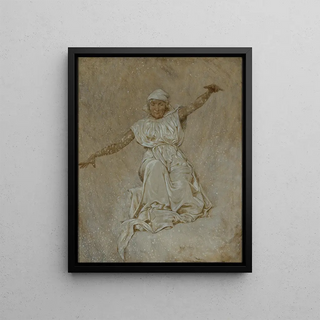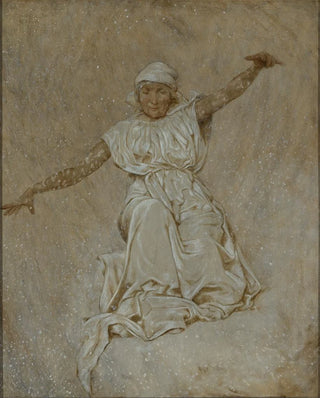Art print | Février Mère Holle - Hans Thoma


View from behind

Frame (optional)
Février Mère Holle - Hans Thoma – Captivating introduction
Within the vast panorama of art history, certain works stand out for their ability to evoke deep emotions and transport the viewer into a dreamlike universe. "Février Mère Holle - Hans Thoma" is one of these creations that, through its visual poetry, invites us to explore the subtleties of nature and imagination. This piece, which evokes the transition between winter and spring, is a true ode to the beauty of natural cycles. Through delicate forms and nuanced colors, Thoma succeeds in capturing the very essence of the season, where the earth prepares to rebirth after its winter slumber.
Style and uniqueness of the work
Hans Thoma's style is particularly characterized by a symbolist approach, where each element of the composition is imbued with deep meaning. In "Février Mère Holle," he blends influences of realism and romanticism, creating a work rich in detail and emotion. The female figures, representing Mother Holle, are surrounded by an enchanting landscape, where snow mingles with the first flowers heralding the return of life. Thoma uses a palette of soft colors, oscillating between the cold blues of winter and the warm hues of spring, to evoke this duality. The harmony of forms and colors contributes to an almost magical atmosphere, where time seems suspended, allowing the viewer to feel the ephemeral beauty of nature.
The artist and his influence
Hans Thoma, born in 1839 in Germany, is a painter whose work is often associated with the depiction of nature and folk tales. His career, marked by an incessant quest for beauty, was nourished by diverse influences, ranging from old masters to contemporary movements of his time. Thoma managed to incorporate a spiritual dimension into his creations, paying homage to mythology and folkloric traditions. As a member of the Black Forest painting movement, he captured the essence of German culture while fitting into a broader artistic current. His work has had a lasting impact on his contemporaries and continues to inspire the

Matte finish

View from behind

Frame (optional)
Février Mère Holle - Hans Thoma – Captivating introduction
Within the vast panorama of art history, certain works stand out for their ability to evoke deep emotions and transport the viewer into a dreamlike universe. "Février Mère Holle - Hans Thoma" is one of these creations that, through its visual poetry, invites us to explore the subtleties of nature and imagination. This piece, which evokes the transition between winter and spring, is a true ode to the beauty of natural cycles. Through delicate forms and nuanced colors, Thoma succeeds in capturing the very essence of the season, where the earth prepares to rebirth after its winter slumber.
Style and uniqueness of the work
Hans Thoma's style is particularly characterized by a symbolist approach, where each element of the composition is imbued with deep meaning. In "Février Mère Holle," he blends influences of realism and romanticism, creating a work rich in detail and emotion. The female figures, representing Mother Holle, are surrounded by an enchanting landscape, where snow mingles with the first flowers heralding the return of life. Thoma uses a palette of soft colors, oscillating between the cold blues of winter and the warm hues of spring, to evoke this duality. The harmony of forms and colors contributes to an almost magical atmosphere, where time seems suspended, allowing the viewer to feel the ephemeral beauty of nature.
The artist and his influence
Hans Thoma, born in 1839 in Germany, is a painter whose work is often associated with the depiction of nature and folk tales. His career, marked by an incessant quest for beauty, was nourished by diverse influences, ranging from old masters to contemporary movements of his time. Thoma managed to incorporate a spiritual dimension into his creations, paying homage to mythology and folkloric traditions. As a member of the Black Forest painting movement, he captured the essence of German culture while fitting into a broader artistic current. His work has had a lasting impact on his contemporaries and continues to inspire the






